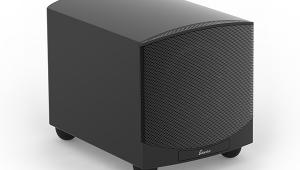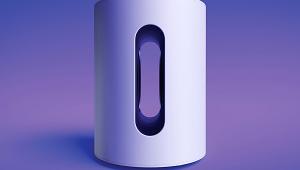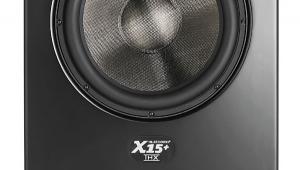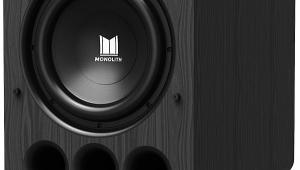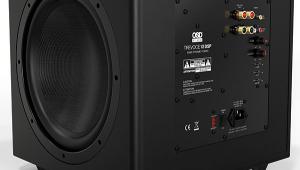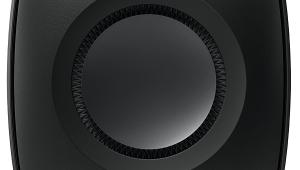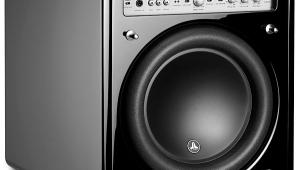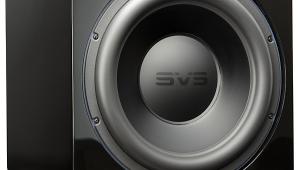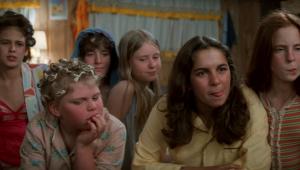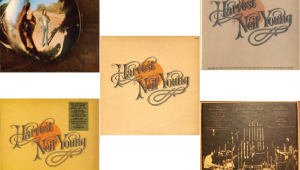The only part I miss slightly from not having a 5.1 system anymore is the sub for some movies. The compact size of this makes it tempting, the cost makes it not.
KEF KC62 Subwoofer Review Page 2
Staying with the same track, I gradually increased the sub's volume control along with my DAC's output-volume control and monitored the result. The little KEF got louder with no loss of bass content to perhaps 10dB more than where I'd been at max with my desktop monitors; beyond that point, while mid-bass from the sub continued to rise, the deep bass stayed the same: bass-dynamics limiting at work, as expected. But no discernible distortion or unseemly noises emanated from the KC62, until the last measure of gain from my DAC (its max output is well over 2 volts), with the sub's volume wide open. Then, on loud kickdrum-bass unisons, the little woofers added a soft "phut" on each note as they found the limit of their travel. (Turning the monitors back on at this level found them deep into their red zone, and indeed one quickly shut down.) Conclusion: KEF did an excellent job at balancing the KC62's electroacoustic systems, extracting all the ultra-compact can give while preventing it from disgracing itself.

How would this tiny tot fare in my big system, supporting much larger, much higher-output 6.5-inch three-way active speakers, and replacing an SVS cylinder subwoofer roughly 25 times the KC62's cubic volume? Let's find out.
Muscling the SVS aside, I placed the KEF in my established subwoofer spot, jacked in power and the long RCA cable running from my pre-pro's sub out into the KEF's unfiltered LFE input, and performed a quick level-balance using the pre-pro's match noise and my iPhone's SPL-meter app. With the preamp's crossover set for 80Hz, I then played the same Fourplay track (via Roon) at a comfortable listening level, making small adjustments to level and crossover in my pre-pro's setup menu. The result was solid, rich sound—just like my system always sounds. To confirm, I swapped back to the big sub a few times and heard no meaningful difference.
This was pretty much what I expected, but to an unjaundiced ear it should be little short of astonishing. At moderate listening levels (75-80dB SPL average, -ish), the KC62 had no difficulty matching my big system's extension, heft, or musicality—this is in a 22 x 16-foot room of roughly 2,800 cubic feet. Track after track yielded the same results. The opening of Prokofiev's "Dance of the Knights" scene from Romeo & Juliet revealed rich, vibrant orchestral bass, with no hint of buzz or woofiness. The Eagles' unplugged "Hotel California," which has strong bass-drum content around 40Hz with "undertones" well below had high-impact, gut-punching slam.
For a natural-acoustic reference, I went back to the Prokofiev. At the moderately loud levels I had been listening at, the KEF did, as I said, excellent work. This was around 76-78dB SPL average: about equivalent to what you might hear from a seat two-thirds back in Boston's Symphony Hall, the space with which I'm most familiar. Adding 4 or 5dB of level—about one-third-back—caused little change: maybe a slightly "lighter/brighter" balance, but there was still plenty of 30-60Hz octave for full impact. Adding another 4 or 5dB and we're now in row three, nosing the stage. Here the difference became obvious, with the much brighter balance begging the question, "Where'd all that rich, deep bass go?"

It didn't go anywhere, of course—it's a balancing act. As my main speakers reached peak concert levels, the diminutive KEF simply ran out of lowest-octaves headroom, and its smart dynamic circuitry curtailed them to prevent audible distortion. Its uppermost half-octave (and the main speakers' remaining 8 octaves), meanwhile continued to amp up. Result? The ear hears "bright," and Prokofiev's rich, chocolatey bassi/contrabassoon/tuba unisons seem to nearly disappear—even though the sub is reproducing them just as loudly as it was at my initial listening level.
Much impressed, I now exercised the nuclear option, "Bass I Love You," by electronica artist Bassotronics, a track with about as much 15-30Hz bass content as you'll find. (All synthetic, of course; you simply won't get this low and loud in nature without military-grade explosives.) At my established "modest" level, the KC62 produced just about all of the infra-bass—the super-low thud, the breathless sort of decompression between pulses, and the descending flutter of sub-25Hz content—with satisfying presence. Switching to my hulking SVS sub again made surprisingly little difference, though the big bruiser was clearly just a bit stronger and more dynamic with this infra-bass stuff. In this case, however, "modest" was the KC62's level limit. Asking even 2dB more from it proved futile: the >100 Hz stuff got louder, but the <60 Hz stuff didn't.

The Downlow
The fact that a literally breadbox-size subwoofer can produce actual 25 Hz-and-lower content at any musically useful level is newsworthy. And so is the KC62 as a whole: if you insist on breaking Hoffman's Iron Law, or at least bending it to its limits, KEF's inaugural Uni-Core design does so as dramatically, and as classily, as any sub I've seen. Within the "iron" caveats of a small room and/or relatively modest level demands, it will match the performance of a well-engineered 12-inch sub in every important parameter except peak dynamics and level. There may be other mini subs on the market, but none I know of go quite as low in quite as small and elegant a package as what KEF has managed with the KC62.
- Log in or register to post comments


Great engineering achievement but to what end? This thing is basically an 11" cube. Going just slightly larger (14-15" cubed) gets you a real quality 12" sub like the Rythmik L12 for only $600.
I fail to see the point of needing to get such a small sub and dealing with the significant cost and output compromises.

I've a Definitive Technology Super Cube 1, which goes to 16HZ in my 1st 5.1 HT. The wife required me to go on a quest for an acceptably invsible HT system for our new home & new primary HT system. The KC62 can do what the Super Cube 1 can do & do it more accurately! Try playing a recording of a space shuttle launch, as realistically as your hearing can stand and you won't be disappointed. This is an engineering accomplishment for size & output.

Small enough to stay out of the way in a workstation system ... hmmm. Might be a good addition to my Altec speakers, that give up around 45-50 hz.
As for other things mentioned:
Here's a story about a 18000 yr old conch shell found in a cave, played: https://arstechnica.com/science/2021/02/listen-to-haunting-notes-from-an...
And there are pipe organs that have extremely low bass. Probably the deepest is the Sydney Town Hall with a true 64' stop (one of only a few in the world). Somehow, I doubt that the mp3's on the web site capture the full range. Could the KEF produce usable output of the bottom octave (8-16 Hz)? https://www.ohta.org.au/confs/Sydney/SYDNEYTOWNHALL.html


